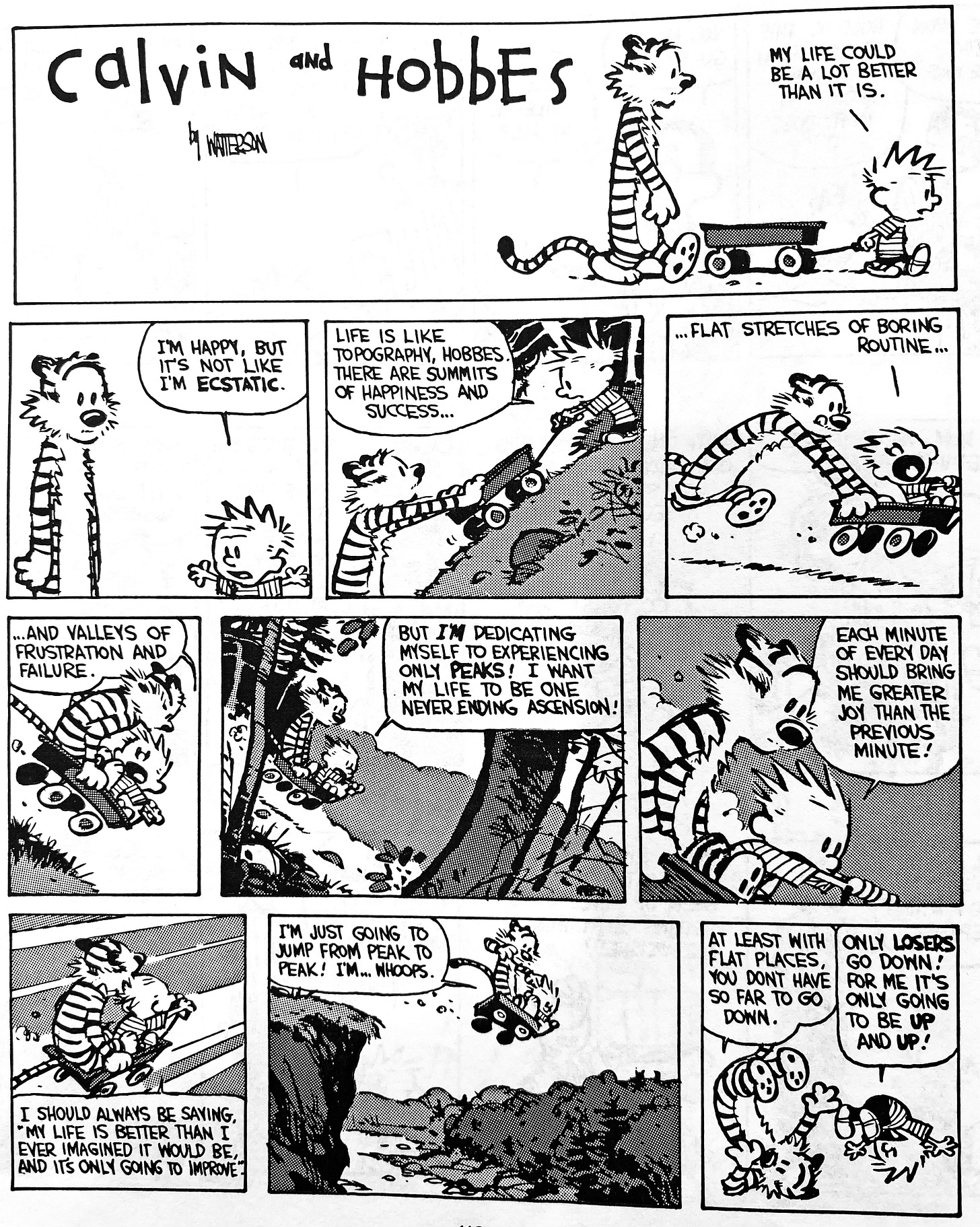Hello, readers! Thank you for sticking with me during our Gen-X parenting series! If you’re just joining us, you can find the four posts here:
Fight the Fertility Crisis with One Weird Trick
Sometimes You Just Have to Be Thirsty
This week’s post will be short and (hopefully) fun. I didn’t have much time for writing this week, because I was away for several days helping my daughter find an apartment near her new job, which she will begin after she graduates from college in June. It is an exciting and poignant time for us older parents as we help our kids get launched into the adult world, and as we watch them embark on new adventures.


Anyway, because our apartment-hunting trip was a kind of final parenting project for me, I thought it would be cute and appropriate to close out this series with a final project for readers too. The cartoon below contains wisdom for parents and kids alike as we navigate life’s journey. Let’s take a look and see what we find!
For the past couple of months, I have been helping my friend’s daughter Silvie prepare for her IB English Language and Literature exam in May. For one part of the exam, students are given an image—a political cartoon, poster, or brochure, for example—which they have never seen before. They have an hour to write an analytic essay about the image. I have been challenging Silvie with a variety of images to help her practice, including this Calvin and Hobbes cartoon, by Bill Watterson:

Silvie grew up in Sudan, Nigeria, Vietnam, Thailand, and Switzerland but has never been to the US and thus had never seen a Calvin and Hobbes cartoon before. She is a gifted painter with a terrific eye for detail, and so I was eager to hear her observations on the visual aspects of the cartoon, especially because she was coming to the cartoon totally fresh. The discussion below is informed by her excellent ideas. Thanks, Silvie!
If you are reading this post on your phone and are having trouble reading the cartoon, here’s the text:
Calvin: My life could be a lot better than it is.
I’m happy, but it’s not like I’m ecstatic.
Life is like topography, Hobbes. There are summits of happiness and success …
… flat stretches of boring routine …
… and valleys of frustration and failure.
But I’m dedicating myself to experiencing only peaks! I want my life to be one never ending ascension!
Each minute of every day should bring me greater joy than the previous minute!
I should always be saying, “My life is better than I ever imagined it would be, and it’s only going to improve.”
I’m just going to jump from peak to peak! I’m … whoops.
Hobbes: At least with flat places you don’t have so far to go down. Calvin: Only losers go down! For me it’s only going to be up and up!
Readers, what is your initial reaction to this cartoon? What do you notice that is interesting or suggestive?
Let’s look at the text first. There is a lot of what I like to call “should-ing”—Calvin says “should” twice, as well as “could be” and “I want.” He keeps asserting that his life ought to be full of peaks, but he doesn’t offer any plan for achieving this outcome. (Should-ing is one reason I find a lot of political writing to be frustrating, incidentally. Don’t tell us what ought to be the case! Tell us what we can do to bring about positive change in the world and our lives!) Of course it’s ok to dream once in a while, but should-ing can delude us into believing that it is somehow a law of the universe that our lives be exactly as we would wish. We can feel cheated out of what we believe is our due, and we don’t realize that, to paraphrase Yoda, there is no “should,” there is only “do.”
In spite, or because, of all this should-ing, Calvin is not actually happy, all claims to the contrary. We can see this from the very first panel, where Calvin seems grumpy and downcast. In the second panel, while Hobbes has a neutral, relaxed expression and posture, Calvin looks all wound up—worried, tense, and even angry.
Calvin’s grim expression persists for most of the cartoon. During his exciting wagon ride through the woods, amid lovely vistas, he never looks around to enjoy the ride. He turns back to Hobbes in panels four and five but otherwise stares straight ahead. In panel four, he is literally levitating, and yet he can only think about “boring routine.”
Silvie noticed that in panels three, four, and five, the images match the text: Calvin mentions summits, and we see him and Hobbes pushing the wagon up the hill. He describes “flat sections of boring routine,” while Hobbes pushes him along a flat patch. And “valleys of frustration and failure” is accompanied by a picture of them racing downhill.
But in panel six, Watterson switches things up. Ironically, at the very moment Calvin insists that he wants his “life to be one of never ending ascension!” he is racing straight downhill. Much as Calvin might wish it were otherwise, he can’t control his life’s path.
The irony continues in the penultimate panel, where Calvin states his intention to “jump from peak to peak.” But there is no peak to catch him; instead, he jumps into the void. Calvin may actually recognize that this abrupt change in plan isn’t all bad: The editor in me couldn’t help noticing that instead of the exclamation mark after “whoops” we might expect, there is only a period. This deadpan punctuation suggests that Calvin is not frightened here but is only registering that something has gone awry.
In fact the cartoon shows that going awry is the best thing that could have happened to Calvin. Every panel except the final one shows left-to-right movement. In the first panel, Calvin is actually marching straight into the black line that marks the edge of the panel. He’s hitting a wall. The final panel marks the sole departure from this pattern. Finally Calvin’s forward momentum is disrupted, and he is turned topsy-turvy. At the very moment Calvin is insisting that he will only be going up and up, he is in fact going down, down, down, while he is also upside-down. Silvie noticed something crucial in this final panel: This is the only place in the entire cartoon where Calvin is smiling—exactly when all his plans have gone wrong.
There’s a lesson here for us all: Take in the view, and take heart. Our lives will take unpredictable turns, so why not enjoy the ride?
How about you, readers? Was there a time your life was upended, and you realized (eventually) that it was the best thing that had ever happened to you? Please share your thoughts in the comments!
The Tidbit
Ups and downs are an inevitable part of life. We can only hope to approach life’s vicissitudes with the grace and beauty Yoann Bourgeois shows in this dance. He makes it look so easy, doesn’t he? But we all know that it takes patience, effort, and courage to bounce back, keep our balance, and try again after we hit the wall. To quote the nineties one-hit-wonder “Tubthumping,” “I get knocked down, but I get up again.” That is what it means to be human.







Watterson has many classics, and this is one of his best. I'm struck by the inverted experience. When sledding or riding downhill, it's the ascension part which is boring and tedious, while the downhill part is exciting and rewarding. It's the opposite of the metaphor of success, climbing the ladder to get higher rewards.
My kids love Calvin & Hobbes and have read all the books several times over, but I never thought to analyze one in such detail. There was a lot more to it than I would have guessed.